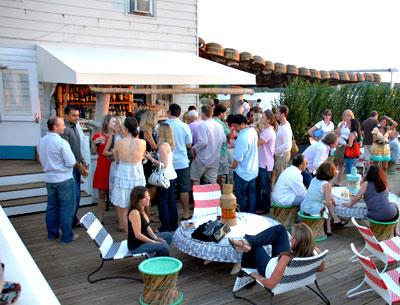Reining in the Party

The East Hampton Town Board is considering a proposal to rein in new bars and restaurants at hotels and resorts and ensure that the establishments have adequate onsite parking to accommodate the additional business that these extra amenities might bring.
The proposed changes would not effect establishments like Montauk’s Surf Lodge or Beach House, which already have accessory bars or restaurants. The law would, however, prevent future similar ventures from becoming nightclubs that dwarf their parent hotels.
The proposed law, which is still under review, would require that any hotel seeking to open a restaurant have at least 25 guestrooms. The restaurant, including its kitchen, would be limited in size to either 20 percent of the total square footage of the hotel or 2,000 square feet, whichever is less, and would have to be constructed within the confines of the existing building. Hotel bars and taverns, which are different from restaurants under town code, would be limited to 10 percent of the total square footage or 1,000 square feet. The motel would have to be operating as such when the restaurant or bar is open.
The regulations could affect 91 existing hotels and resorts in the town, with over 40 having the required 25 or more rooms, according to Elizabeth Baldwin, an assistant town attorney who is working on the legislation. The goal, she told the town board on Tuesday, is to prevent such businesses from “morphing into nightclubs.”
The draft law also attempts to address residents’ complaints about overflow parking which crowds nearby streets. It would mandate that the motel provide not only the parking spaces required for its overnight guests and employees, but an additional space for every two seats in the restaurant.
Special permits for new restaurants would only be issued by the town planning board if the businesses can demonstrate that they meet the parking requirements and are “compatible with the neighborhood.” Heavy screening and double setbacks would help protect residential neighbors.
In addition, “We prohibit takeout. The purpose of accessory use is that it is supposed to serve the guests,” Ms. Baldwin said.
“We should proceed through this,” Town Supervisor Larry Cantwell said. “The devil is always in the details.” Other board members seemed equally supportive of the measure. Mr. Cantwell encouraged Ms. Baldwin to meet with the Montauk Chamber of Commerce and other like-minded business organizations as the bill is honed to its final form.
The supervisor then asked a broaderquestion: “How many more nightclubs do we want?” He said that nightclubs were not simply a byproduct of hotels and resorts.
A number of cautionary tales in Montauk prompted the proposed changes. Two years ago, when the Montauk Beach House in the downtown area was looking to open a poolside bar, the town’s zoning board of appeals had to first settle the question of whether that constituted a second business on the property. Richard A. Hammer, the owners’ attorney, offered the board legal precedent in the form of a 1968 New York State Appellate Court decision, which said that “the service of liquor refreshment is inseparable from a modern hotel and as a matter of law a bar therein is an accessory use.” The Beach House bar has become a popular destination in its own right, with hundreds of poolside guests arriving for weekend music shows.
Perhaps even more popular is the Surf Lodge on Edgemere Street, which new owners renovated into a chic hotel and nightspot. During the season, patrons’ cars line Edgemere Street in both directions to the consternation of many residents.
At its meeting on Tuesday, the town board also discussed the future of Second House Museum. Built in 1797, it is the oldest house in Montauk. It was purchased by the town, in partnership with the New York State Historical Society, in 1968.
Now Second House’s electrical wiring is dangerously outdated, Gregory Donahue of the Montauk Historical Society told the board. “It could burn down on a summer day,” he said.
The town spent $350,000 on the structure’s rehabilitation less than 10 years ago, he said, but the work was slipshod. For example, he told the board, ungalvanized nails were used to attach shingles to the roof. In addition, work done previously on the interior of the building lacked a cohesive plan.
“Last summer we were not able to open it, and this summer we won’t be able to open, again,” said Dave Webb, another member of the society.
Mr. Cantwell said that the town was in the process of putting together a lease agreement allowing the society to take over the building, the first step toward doing the needed renovations.
